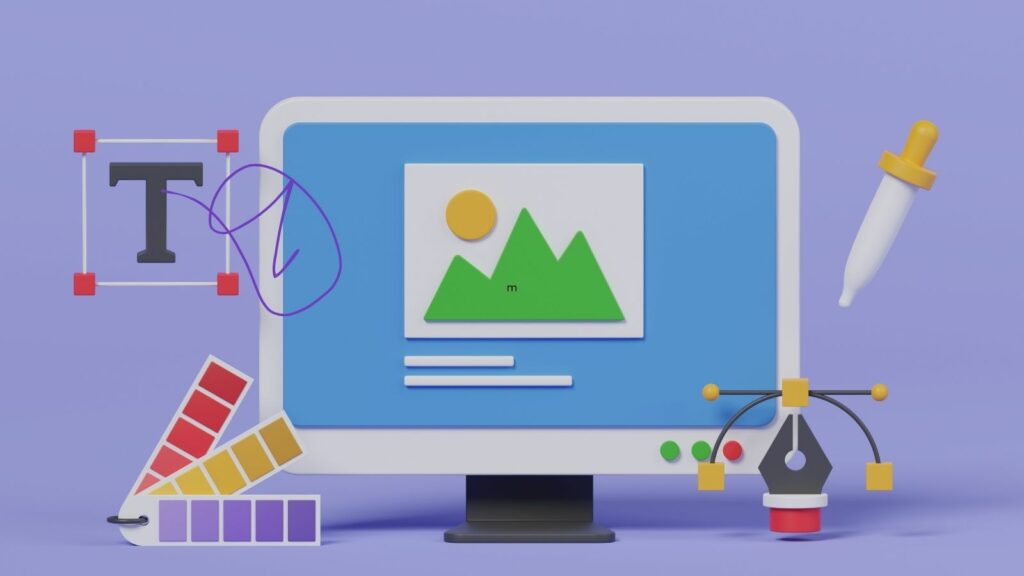Whether you work for an agency or as a freelancer, the graphic design process can be tons of fun! It can also be a huge pain sometimes. Especially when you keep running into the same delays that hinder the creative design process.
The steps of the graphic design process may not change very much in the years to come, but there are ways that you can do it better.
In this post, we’ll explore:
- The steps of the graphic design process
- The biggest time wasters in process
- Ideas for working more efficiently
- Strategies for avoiding common bottlenecks
Just want the productivity tips? Skip ahead here.

What steps does a graphic designer go through in the graphic design process?
The graphic design process consists of a series of steps a graphic designer goes through to bring ideas to life that will serve a client’s goals. Here are the graphic design process steps:
1. Write the creative brief
The first step of the process is to get everyone aligned on the client requirements for the particular project through an official document. The creative brief (or design brief) helps give everyone a better understanding of what the client needs and what’s expected from the creative team.
2. Conduct research
In the research phase, the designer or the agency conducts market research to discover relevant information about the project’s target audience to help inform design concepts. In this stage, they’ll get to know what design elements or color schemes appeal to the audience and will also review competitor designs to see how they can potentially stand out with quality design.
3. Develop the initial concept
This is what we also call the design stage or concept development stage. Taking all the valuable information that was discovered in the research stage, the designer will get to work using design software like Adobe Creative Cloud programs, Sketch, Figma, and others. Their mission is to come up with an initial concept or several variations that they can present to the client in the next stage.
4. Present the initial concept and collect feedback
In this stage, the designer or agency will bring design ideas, a rough draft, or a rough framework to the client and begin collecting feedback. The designer will likely have to welcome different perspectives and input from project stakeholders to consider in the revision process that comes next.
5. Refine/iterate the design according to feedback
Following the presentation of the initial design, the graphic designer should be able to walk away with a clearer idea of what the client wants to see in the final design From there, they’ll incorporate a list of requested changes from the client for the next iteration into a successful design.
6. Get final approval/ client sign-off
The presentation and revision stages can be repeated as many times as needed. Once the client is completely satisfied with the final design, the graphic designer or agency will get final approval. All final files get delivered to the client, and the design is considered to be a finished product.

What are the biggest time wasters in the graphic design process?
1. Collecting information from clients
After sealing the deal with a new client or agreeing on a project, the next thing the agency or graphic designer will do is collect all the assets and information they need from the client to start designing.
Typically, this information is received via tons of different emails from the client, and this wastes time in a few different ways:
- Time spent writing multiple emails to the client to remind them to send over the content.
- Time spent searching for correct files in the email inbox.
- Time spent recreating elements that are misplaced or not received.
- Running into issues receiving large files over email and having to find an alternative.
- Receiving the wrong files, and getting confused about which image or attachment is the correct or most up-to-date version.
Solution: use data collection software
We recommend taking all these exchanges off email and switching to a proper data collection tool instead.
Here’s how you save time by making the switch to these software tools:
1. Data collection tools come with pre-written email templates you can use to reach out to your clients in half the time.

2. Using data collection software helps you centralize all your client information in one place rather than having to scour your email inbox to find bits and pieces.
3. Most of these tools are built so that you can easily receive large file sizes from clients without any issues.
4. Once you send out a request for information, the tool will automatically remind the client to send you their information by a deadline so that you don’t have to keep doing this yourself.

5. Some data collection software allows you to accept or reject content as you receive it. Rather than realizing that the client sent you the wrong logo too late in the design process, you can be on top of making sure that what you receive is correct.
The features we mentioned in this list are features that our very own Content Snare offers, but not every data collection tool will offer all of them.
To explore your options, read 8 of the best form builders and how they stack up or save yourself time and start a free trial of Content Snare.
2. Interpreting unclear creative briefs
One of the biggest time wasters for graphic designers is a poorly put-together creative brief. If the design brief is too vague, open-ended, or confusing, it’ll only lead to countless misunderstandings resulting in project deliverables being way off. When the initial concepts don’t align with the brief, they’ll need to spend additional time making design revisions.

Solution: develop strong creative briefs before getting started
Sometimes the client will do a poor job at putting together briefs, so it’s up to you to step in and develop a design brief that the creative team is confident in working from.
Here are a few tips and resources for developing an accurate creative brief:
- Ask your client as many specific questions as you can in the client discovery phase to help inform your brief. The more detail you can get on their specific project needs, goals, and market the better.
For guidance on what you can ask, read How to create the perfect design request form.
To save time coming up with questions altogether, use our pre-built graphic design questionnaire. - Learn how to develop your brief step-by-step in our blog post How to write a creative brief.
3. Poor and messy communication
Creative teams can struggle immensely with communication when collaborating with one another or with the client. Far too often, they can run into unproductive back-and-forth conversations, massive delays in getting feedback, and untimely project updates.
Without figuring out how to communicate better early on, graphic designers and agencies can waste critical time:
- Consolidating client requests from meetings, emails, Slack messages, and other platforms.
- Not being able to resume any work as they wait for client approval on design ideas.
- Trying to improve communication better through trial and error without achieving any real success.

Solution: set a communication cadence during client onboarding
Our advice for avoiding miscommunication is to tackle your communication expectations during the client onboarding process. Some ways to save time and avoid hiccups are to:
- Assign a central point of contact to keep everyone on the same page.
- Choose a preferred communication channel, like Slack, email, or phone meetings, and don’t accept any updates outside of those.
- Agree on a communication schedule that works for everyone, whether that means expecting client feedback within 24 hours, or having a short meeting about the project status once a week.
We talk about this in more depth in our blog 5 client onboarding best practices for making a lasting first impression.
4. Inefficient feedback loops
How well an agency or freelancer collects and implements feedback is another thing that greatly impacts productivity in the graphic design process. If client feedback and revisions aren’t managed efficiently, it can lead to the need for multiple rounds of revisions, delaying the final product.
Solution: re-work the entire feedback process itself
Here are a few tips for improving feedback:
- Implement collaboration tools that make leaving feedback easy. Tools like Figma offer commenting and/or visual annotation features, allowing multiple team members or clients to share their thoughts on initial designs and design revisions directly on the design files, helping to get rid of plenty of back-and-forth.
- Set up dedicated feedback meetings with the sole purpose of collecting comprehensive feedback on a presented design. These meetings can be used to clarify design intentions, collect a round of feedback from all parties, and address concerns immediately.
- Create feedback templates that give more structure to the feedback process. Feedback templates can include sections to leave general comments, raise specific concerns, or call out areas that need improvement.
Tip: you can use data collection tools like Content Snare for more than just one purpose. Use them to collect client information as well as client feedback! - Schedule post-implementation review sessions to ensure that all revisions meet expectations entirely. This helps ensure that the feedback loop is closed effectively and that nobody has any further concerns.

5. Accepting scope creep
Too often, what a client needs and wants changes throughout the graphic design project. They might suddenly realize they want a new color palette, social media imagery, a website refresh, or an urgent tweak to their existing logo design on top of what you’ve agreed to deliver.
If you don’t have clear boundaries, you can end up spending more time doing plenty of extra work that wasn’t agreed on. This ends up delaying other parts of the project and can delay the finished product altogether.
At the same time, how can you say no to a client you want to impress? We get it. You won’t exactly want to deny them of their asks.
Tackling scope creep is a bit of an art. There are two ways you can do this properly.
Solution 1: get project scope sign-off
Before you start the creative design process, check in with your client one more time and get them to sign off on the official project scope and finalized brief. Formally confirming the project scope like this is a way to set clear boundaries and communicate what is and what isn’t included.
For example, let it be known that you’ll be delivering only 3 logo concepts and that the scope does not include the development of a brand identity or brand guidelines. This is your chance to remind the client that if they want to see 2 more logo designs or branding work, it will be subject to additional pay.
Solution 2: use change orders
A change order is a formal document that you use when the client requests any changes or additions that go beyond the project scope. It outlines the requested changes, the costs involved, and how the new requests will affect the project timeline or alter deadlines.
Using change orders is a professional way to remind the client that their requests will involve more resources. Let’s say a client asks for a 1-page press kit at first, but now they want 3 pages. This is an example of a time that you’d want to use a change order to justify the extra time it will take you to design those extra two pages.
Change orders can even be a sneaky tool for making the client shy away from unnecessary requests once they see how much more it’ll cost them!

A final piece of advice for graphic designers
Even though you might have an established graphic design process, there are always ways to improve it through the introduction of technology, productivity hacks, or added levels of communication. We recommend revisiting each step of your process every so often to find one or two things you can improve in every step
We hope you enjoyed these productivity tips and learned something new. Now you can look forward to getting your work done more efficiently so you can open up your time for more exciting projects …. or use that free time to chill out instead. We won’t judge!



